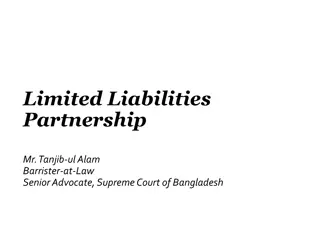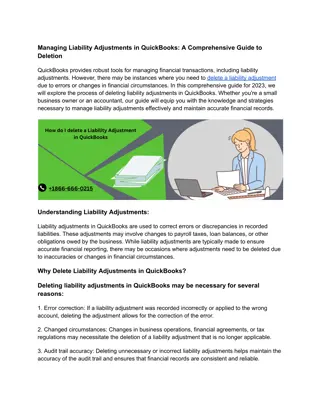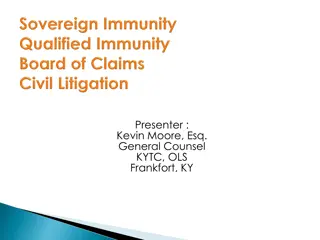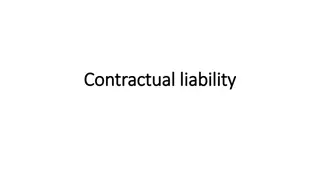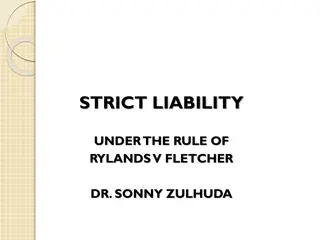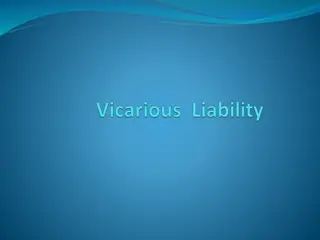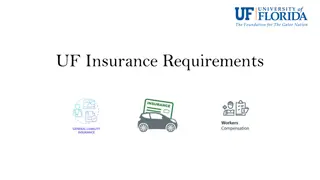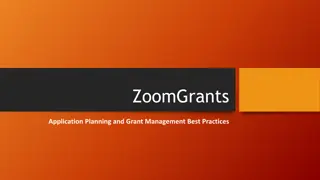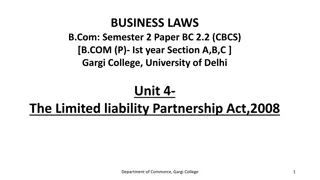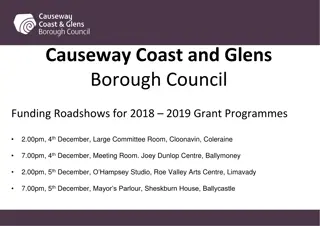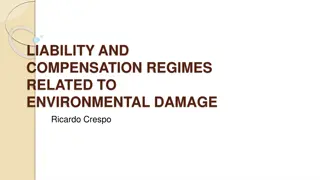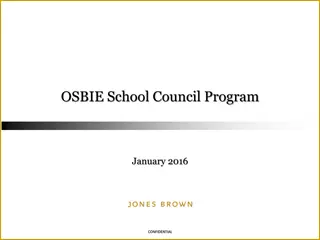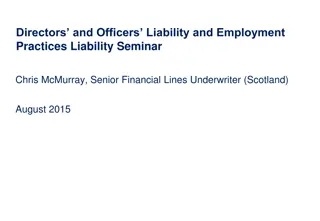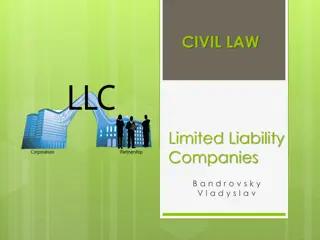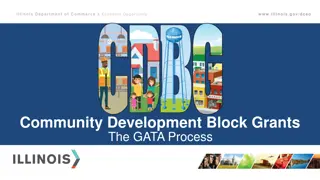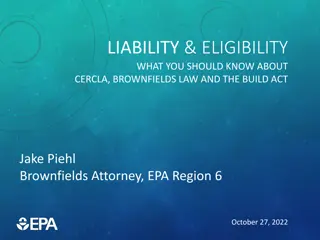GMA Safety & Liability Grant Overview 2019
Participant eligibility criteria for the GMA Safety & Liability Grant include current payment of contributions and fees, participation in LGRMS training programs, designation of a Safety Coordinator, and policies on safety meetings and self-inspections. Requirements must be met to qualify for the grant. Compliance with safety policies and completion of training are essential for grant eligibility.
Uploaded on Sep 12, 2024 | 0 Views
Download Presentation

Please find below an Image/Link to download the presentation.
The content on the website is provided AS IS for your information and personal use only. It may not be sold, licensed, or shared on other websites without obtaining consent from the author. Download presentation by click this link. If you encounter any issues during the download, it is possible that the publisher has removed the file from their server.
E N D
Presentation Transcript
2019 GMA Safety & Liability Grant Overview dbeck@lgrms.com 678 686 6280
Grant Requirements / 2019 Changes Agenda Safety Action Planning and loss analysis
GMA Grant Results GIRMA WCSIF TOTALS # of Grants Paid # of Grants Paid # of Grants Paid 102 # of Grants Requested $s Requested 196,937 $ 146,155 $ 269,737 $ 287,754 $ 377,000 $ # of Grants Requested $s Requested 308,229 $ 225,481 $ 232,630 $ 296,583 $ 280,000 $ Year $s Paid $ $ $ $ $ $s Paid $ $ $ $ $ $s Paid $ $ $ $ $ $ $ $ 2,515,040 $ 2014 2015 2016 2017 2018 2019 2020 2021 82 78 80 62 81 40 38 57 62 71 196,937 125,919 269,737 287,754 349,971 82 78 80 59 71 62 52 58 59 65 302,229 193,888 229,630 296,583 262,392 499,166 319,807 499,367 584,337 612,363 90 115 121 136 0 0 0 - - - TOTALS 383 268 1,277,583 $ 1,230,318 $ 370 296 1,342,923 $ 1,284,722 $ 0 564
Participant Eligibility To be eligible for a grant, a member must meet the following criteria: Current in payment of contributions and fees. Participation by any member employee in at least one LGRMS sponsored training program within the past year of the grant request. If applicable, current in response to recommendations made by LGRMS during an on-site visit. Designation of a specific person as the member Safety Coordinator. NOTE: The designated Safety Coordinator is expected to attend Introduction to Local government Safety Coordinator Modules 1,2, & 3. We look back a year from the application to see if the required course has been completed. Show proof of a written policy on holding safety meetings/training. A minimum of one per quarter is required. NOTE: This policy must be signed by the Mayor and City Administrator/Manager for cities or Executive Director for authorities. The meetings requirement can be met through meetings involving safety committees, employee training sessions or departmental heads meeting to discuss safety topics. The safety training sessions may involve safety related video presentations, instructional safety talks or open discussions on safety issues. The city s designated Safety Coordinator should be involved with this commitment. If your written policy was approved in the previous year, you will not need to resubmit the written policy, but you will need to submit verification that meetings took place.
Participant Eligibility (Continued) Show proof of a written policy on requiring a minimum of two safety self- inspections per year. A minimum of one every six months is required. NOTE: This policy must be signed by the Mayor and City Administrator/Manager for cities or Executive Director for authorities. Self-inspection forms are available as part of Safety Coordinator training sessions and a sample form is available on the LGRMS website, www.lgrms.com. You will not need to resubmit the written policy if approved the previous year, but you will need to submit proof of inspections each year. Show proof the Safety Meeting/Training Policy and the Self-Inspection Policy mentioned above have been implemented. This can be copies of meeting minutes, sign-in sheets showing the topic of any safety training program, and completed self-inspection forms. Show proof there is a written mandatory Seat Belt Usage Policy signed by the current Mayor and City Administrator/Manager for any city or the Executive Director for any authority. This policy should apply to anyone conducting city/authority business that is riding in or driving owned/operated vehicles or operating construction equipment equipped with seat belts. You will need to provide a description of how this policy was distributed to all employees. Only for those members with premiums over $100,000 - Show proof that the member s leadership and safety team have reviewed applicable loss trends over the last five years and developed goals and associated action plans to address those trends. Safety Action Plan instructions and templates are available from your Loss Control Field Representative, at www.lgrms.com, and will be distributed electronically with this grant application.
Program Guidelines The grant will pay 100% for all approved items according to the schedule below:
Examples The City of Happyville pays $330,147 in GIRMA and $143,000 in WCSIF. The would be eligible for a $10,000 GIRMA Grant and a WCSIF Grant $7,200 The City of Partytown pays $15,655 in GIRMA and $3,655 in WCSIF. The would be eligible for a $3,000 GIRMA Grant and a WCSIF Grant $1,800. The City of Cleanville pays $94,147 in GIRMA and $58,000 in WCSIF. The would be eligible for a $4,700 GIRMA Grant and a WCSIF Grant $3,000.
Program Guidelines (Continued) The GIRMA grant will also reimburse 50% of the cost HR Express and 25% of cost of IT in a Box. No supporting documentation required. HR Express is designed to help cities stay informed of and compliant with numerous human resources laws and regulations. IT in a Box is designed to help cities take proactive action against cybersecurity risks by deploying modern up-to-date technology, policies, and best practices.
Program Guidelines (Continued) A documented mandatory use guideline or SOP signed by the department head and either the Mayor, top Administrator, or Executive Director must be included for each safety equipment request. This is generally required for types of equipment such as respirators, AED s, trenching equipment, confined space apparatus, body armor, body cameras, etc. Grant funds will be distributed on a first come, first approved basis until all eligible funds have been expended. The purchase must be made during the current calendar year that runs from 1/1 to 12/31. The review of 2018 grant applications will begin 2/1/18. All grant applications must be received or post marked before 10/31/18. Please avoid submitting multiple grant applications. The grant request must be signed by the Mayor or top Administrator for cities or the Executive Director for all other organizations.
Procedures to Request Grant Monies Determine you have a need that fits the intent of the grant program. Determine all requirements have been met. Please see enclosed checklist. Complete the application. Gather the necessary documentation to include the following: Copy of the properly signed mandatory use policy or SOP for any equipment purchase. Copy of a purchase order or list of items with expected cost if considering a purchase. Copy of a paid invoice or receipt if purchase has already been made. Copies of the written policies for the required safety meetings/training, self-inspections, and seat belt usage policy. Please include any required proof of meetings, self- inspections, and seat belt usage policy training or distribution. Submit the completed application, along with documentation, to LGRMS, 3500 Parkway Lane, Suite 110, Norcross, Georgia 30092. You may also scan and e-mail to lgrmsadmin@lgrms.com and/or Dan Beck at dbeck@lgrms.com. Wait to receive a confirmation, denial or a request for additional information. Grant funds will be released upon final receipt of paid invoice/bill. If additional information is requested, gather the information and return it to LGRMS.
Program Administration Each submitted grant request will be subject to approval by a committee made up of the Deputy Executive Director (RMEBS), the Director of Risk Management Services, and the Director of LGRMS with input from the appropriate LGRMS Field Representative. Priority will be given to grant requests that have a direct impact on employee safety or the reduction of liability potential. The Committee will have final determination as to whether a grant request meets the overall intent of the program. Each fully completed request will be logged into the master list of requests and processed in the order received. Incomplete requests will not be recorded into the master list until all necessary documentation has been received. All requests will be acknowledged as to whether it has been approved, not approved, or partially approved. Funds will only be dispensed after final documentation has been received for the necessary approved purchase or expense. Any grant request received after all funds have been used up will be returned to the member.
Grant Process Timeline: (Average payment processed in 3 to 4 months) LGRMS receives your grant application, identifies any issues with your documentation, and sends the member an acknowledgement e-mail with any needed documentation. This will usually take 2 to 6 weeks. LGRMS will review your application with the GMA Grant Board. This Board will either approve or decline the items you have requested. This will usually take an additional 2 to 6 weeks. LGRMS will then send the member an e-mail indicating the items approved for the grant. The member will then purchase the items requested and send LGRMS the proof of purchase documentation. Once received, it will usually take 2 to 6 weeks to deliver your check.
WCSIF or Workers Comp approved items Can the item requested reduce the risk of employee injury or workers compensation claim? If so, it is likely to be approved. Typically approved items include: training videos, fee for attending a safety course or seminar, purchasing related services, and equipment such as soft body armor for law enforcement officers, reflective vests/garments, confined space entry or retrieval equipment, trench boxes or shoring equipment, chemical handling gloves, aprons, face shields, respirators, etc.
GIRMA or Property & Liability approved items Can the item requested reduce the risk of a property & liability claim? If so, it is likely to be approved. Typically approved items include: training videos, fee for attending a liability course or seminar, purchasing related services, department accreditation or certification fees (i.e. CALEA, Georgia Chiefs), and equipment such as playground enhancements (i.e. netting, sand, cross ties, etc.), traffic control (i.e. barriers, cones, fencing, signs, flagger cert, flares, beacons), Vehicles (i.e. safety lights and camera systems), Law Enforcement (i.e. gun locking devices, in- car/ body/ taser cameras, etc.).
Category Chemical Chemical Chemical Cyber Electrical Electrical Electrical Electrical Electrical Electrical Electrical Electrical Electrical Electrical Item Sorbent Pads (Cleaning supplies for chemical spills) Spill Kits ( Cleaning supplies for chemical spills) Spill Containment Pallet IT in Box CON Red/Blk Rubber Gloves Electric Gauge (2) - Fluke T5600 Glove Bags Gloves Tested and Furnished Personal Voltage Detector Protective Grounding Table ( Protection from high voltage) Protector 6" Con Cuff ( Ruber glove protector) Rubber Gloves and Testing Ruber Glove Testing Long Sleeve Button Down Fr Shirt (Procetion from arc flash hazard) 12,000LB Crane Lift-Reduces back injuries Anti Fatigue Matting Appliance Hand Truck Cargo Trailer 8.5 x 20 (Carry safety traffic equipment) Enclosed Cargo Trailer (Store and dispense safety equipment) Key Cutting Machine Magnetic Lid Lifter (Used to lift metal man hole covers) Varidesk Anti-Fatique Mat Modjoul Smart Belt(ergo for back) 12 Ballistic Helments for Firefighters Breakaway fire vest Evacuation Cribs Extract Washer Stations( Firefighter health) Fire Dept air cyinders Fire Dept. Bunker Equip Firefighter Turnout Gear Genesis Rescue Strut (Hydrolic Lifting Device) Hex Armor Extraction Gloves MultiRAE Monitor( Detects Contaminants in the air for fire investigators) Quantifit Respirator Fit Test (Ensure the facepieces for breathing apparatus are working) Roll N Rack Hose Roller(Reduce back injuries) Rollnrack (support for lifing fire hoses) Self Contained Breathing Apparatus (Fire fighter) Stop the Bleed Supplied Air Systems (respirators) Thermal Imger 2-way radios Rescue Equipment Prusik cord(786') Flat Webbing, Life Safety Rope, Bage Rescue Rack, Pulleys, Carabiners, Grip Rop Grab WCSIF x x GIRMA x x x x x x x x x x x x x x x x x x Ergonomic Ergonomic Ergonomic Ergonomic Ergonomic Ergonomic Ergonomic Ergonomic Ergonomic Fire Fire Fire Fire Fire Fire Fire Fire Fire Fire x x x x x x x x x x x x x x x x x x x x x x x x x x Fire x Fire Fire Fire Fire Fire Fire Fire Fire x x x x x x x x x
Ineligible Requests The grant will not cover personal safety equipment (i.e. hard hats, general use safety glasses, safety shoes, disposable gloves, flashlights, etc.); weapons of any type; staff salary costs; general training requirements for a specific position (i.e. the police or fire academy training programs); general equipment that can be used for multiple purposes (i.e. computers, furniture, etc.); or Association Dues / fees.
Action Planning / Loss Analysis Recommended General Actions: Action Planning and data analysis can be overwhelming. As you know, when things get overwhelming, we tend to just give up. Don t get overwhelmed, only attempt to take action on those recommendations on which you have the required resources. I would rather see you take action on one recommendation and do it very well, than take on several actions that you can only half support. 1. Review your organization s loss history with your organization s leadership. Identify your organizational reduction goals for the future and obtain their support for required actions. (Your Loss Control Field Rep can provide you with member specific loss analysis.) 2. Identify Departments with high rates of incidents. Work with those department leaders to develop department specific action plans based on their incident trends. (I will have specific departmental recommendations below).
Loss Trend Analysis How to Complete "Loss Trend Analysis" Section 1. Your Loss Control Field Rep can provide you with member specific loss analysis, but if you have less than 51 employees please use the data provided within the "WC Analysis" and "PL Analysis" worksheets. The data within these worksheets represents losses for the entire GMA's Workers' Compensation (WCSIF) and Property & Liability (GIRMA) insurance pools for the last 5 years. This large sample size of data is actually a greater predictor of loss trends for similar type organizations. 2. Review your organization s loss history with your organization s leadership. Identify your organizational reduction goals for the future and obtain their support for required actions. 3. Identify at least two departments with the highest rates / costs and document those within the "Top Department by % of Claims Dollar" section. 4. Identify at least two loss types with the highest rates of incidents. Document those within the "Top Loss Type by % of Claims Dollar" section.
GMA WCSIF or Workers' Compensation Pool Member's Loss Analysis 2010 to 2014 Top Departments by % of Claims Dollars Department Police Department # % of Claims Dollars 1 2 3 4 5 36% Public Works Department Utilities Fire 17% 15% 9% Landfill, Waste Removal, Recycling 4% Top Loss Types by % of Claims Dollars Loss Type Ergonomic Incidents (excessive force, repetitive motion, awkward postures, lifting, bending, pushing pulling) Walking Working Surfaces (Falls same Level, Falls different Levels) Motor Vehicle Incidents # % of Claims Dollars 1 33% 2 24% 19% 3 Police Department's Loss Types by % of Claims Dollars # Loss Type % of Claims Dollars Motor Vehicle Incidents Ergonomic Incidents (awkward postures 9%, Lifting 6%, Job Tasks 5%) Walking Working Surfaces (Falls same Level 10%, Falls different Levels) 34% 1 2 23% 3 12% 4 5 6 Altercations Foot Pursuit Physical Training 11% 6% 4% Public Works Department's Loss Types by % of Claims Dollars Loss Type # % of Claims Dollars 1 Ergonomic Incidents (excessive force, repetitive motion, awkward postures 12% , lifting 14%, Job Task 5%, pushing pulling 4%) 35% Walking Working Surfaces (Falls same Level 18%, Falls different Levels 10%) 2 29% 3 4 5 Motor Vehicle Incidents Struck By Caught Between 13% 11% 5% Utilities Landfill, Waste Removal, and Recycling Department's Loss Types by % of Claims Dollars Loss Type # % of Claims Dollars 1 Ergonomic Incidents (excessive force, repetitive motion, awkward postures 8% , lifting 12%, Job Task 5%, pushing pulling 5%) 33% Walking Working Surfaces (Falls same Level 23%, Falls different Levels 11%) Motor Vehicle Incidents Struck By Caught Between 35% 2 3 4 5 6% 7% 10% Fire Department's Loss Types by % of Claims Dollars Loss Type # % of Claims Dollars 1 Ergonomic Incidents (excessive force, repetitive motion, awkward postures 12% , lifting 19%, Job Task 11%, pushing pulling 6%) 54% 2 Walking Working Surfaces (Falls same Level 12%, Falls different Levels 10%) 22% 3 4 Motor Vehicle Incidents Struck By 5% 12%
GMA WC Claims Rate # of Claims > $500 / 100 Employees
City - All Departments Analysis Admin accounts for 4% of claims and 2% of claims dollars. Maintenance accounts for 2% of claims and 0% of claims dollars. Police accounts for 35% of claims and 77% of claims dollars. Parks / Rec accounts for 24% of claims and 3% of claims dollars. Roads accounts for 16% of claims and 9% of claims dollars. Utility accounts for 2% of claims and 0% of claims dollars. Sanitation accounts for 18% of claims and 8% of claims dollars.
City - All Departments Analysis Ergonomics accounts for 25% of claims and 12% of claims dollars. LE Ops accounts for 9% of claims and 37% of claims dollars. Motor Vehicle accounts for 4% of claims and 0% of claims dollars. Non-Cat accounts for 39% of claims and 13% of claims dollars. Other accounts for 11% of claims and 0% of claims dollars. Slip/ Falls accounts for 14% of claims and 37% of claims dollars.
City - Police Analysis Ergonomics accounts for 16% of claims and 6% of claims dollars. LE Ops accounts for 16% of claims and 48% of claims dollars. Motor Vehicle accounts for 5% of claims and 0% of claims dollars. Non-Cat accounts for 47% of claims and 2% of claims dollars. Other accounts for 5% of claims and 0% of claims dollars. Slip/ Falls accounts for 11% of claims and 44% of claims dollars.
Action Plan How to Complete "Action Plan" Section 1. Schedule meetings with the Leaders of the departments that you identified with the highest rates / costs. Review the loss history specific to their department (If you have less than 51 employees please use the data provided within the "WC Analysis" and "PL Analysis" worksheets). Document the names of each identified department within "#1 Focus Department" & "#2 Focus Department" boxes. 2. Identify one or two loss types with the highest rates/ costs that apply to each department and document within the "Department Loss Top Focus" Box. 3. Establish a target/ goal for each loss type you have identified. For example: If you had 20 motor vehicle incidents last year, you might want to set a 25% reduction this year and a goal of 15. Setting a result target / goal allows you to measure the success or failure of your efforts. Document this goal within the "Department Risk Reduction Goal" box. 4. Once you have identified a focus area and established a goal, brainstorm ideas on how to reduce these incidents. Although training is a good part of a plan, without establishing an entire performance chain you can't expect to make significant changes in culture or behavior.
LGRMS Risk Reduction Loss Trend Analysis and Action Plan Anytown, GA 2015 Year: Member: Loss Trend Analysis Top Departments by % of Claims Dollars Department Police Department Public Works # % of Claims Dollars 36% WC / 44% PL 17% WC / 10% PL 1 2 3 4 Top Loss Types by % of Claims Dollars # Loss Type Ergonomic Incidents (excessive force, repetitive motion, awakward postures, lifting, bending, pushing pulling) % of Claims Dollars 33% WC 1 2 Walking Working Surfaces (Falls same Level, Falls different Levels) 24% WC 3 4 5 Motor Vehicle Incidents 19% WC/ 17% PL Police Operations 21% WC/ 21% PL Human Resources (Hiring, Termination, Harassment, Discrimination 17% PL Action Plan #1 Focus Department Police Department Department's Loss Types Focus Motor Vehicle Incidents 34% WC and 29% PL Department's Risk Reduction Goal 2014 we had 12 MV Incidents, our goal for 2015 is 6 Target Date Action Item Owner's Name Status # 1 Communicate the target/goal and its status to Department in monthly meetings. You may want to include within employee evaluations. Chief Smith Feb-15 Open Enhance or develop Motor Vehicle Policy (LGRMS has several examples of MVPs) Investigate all Motor Vehicle Incidents, no matter severity. Identify root cause, and corrective action. Communicate results of investigation to department staff. 2 Captain Wilson Apr-15 Open 3 Chief Smith 15-Jun Open 4 Provide training on Motor vehicle related expectations, Policy and incident trends to entire Police Force (Local Gov U is a great resource for this type of training) Captain Wilson 15-Jun Open Provided feedback during supervisor ride-alongs Supervisors 15-Aug Open 5
Accountability/ Performance Chain Accountability Performance Chain --- =Setting clear expectations =Removing barriers =Ensuring employees are capable =Providing quality training and tools =Providing feedback =And if necessary establishing consistent consequences 5. Document each action item you plan to take within the "Action Item" box, also document with the person who is responsible to ensure completion of the item within the "Owner's Name" and the date you plan the item to be completed within the "Target Date" Box.
Leadership Authorization/ Approval Leadership Authorization / Approval 1. Once you have completed and approved all previous steps please review these with your organization's leadership and obtain their signature for authorization and approval. You can find an example of a completed Analysis and Action plan within "Completed Example" worksheet.



